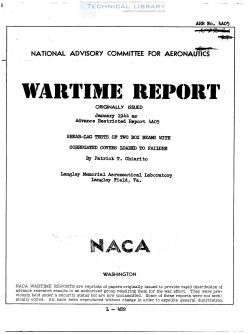naca-wr-l-482
- Version
- 66 Downloads
- 797.18 KB File Size
- 1 File Count
- April 2, 2017 Create Date
- April 2, 2017 Last Updated
Shear Lag Tests of Two Box Beams with Corrugated Covers Loaded to Failure

SUMMARY
Strain measurements were made on the compression side
of two box beams with corrugated aluminum—alloy covers
loaded to failure. Angles formed from sheet were used for
- corner flanges in beam 1; whereas extruded angles were
used in beam 2. By use of the shear-lag theory the stresses
in the corner flanges at the root could be predicted to
approximately 10 percent for beam 1 and 5 percent for bean12.
Failure in each beam occurred in the corner angle at a stress
that was above the compressive yield stress for the material.
INTRODUCTION
Little experimental evidence has been published here-
tofore concerning the reliability of the shear-lag theory
at high stresses. Reference 1 reported the results of
tests made at the Langley Memorial Aeronautical Laboratory
of box beams with flat cover sheets and Z-stiffeners loaded
to destruction. Tests have recently been made of box beams
with corrugated covers; the experimental results of these
tests are presented herein and are compared with theoretical
results obtained by the shear-lag theory of reference 2.
BENDING TESTS OF THE BOX BEAMS
. Test s5ecimmns.- Two box beams with constant cross
sections an corrugated covers were used for the tests.
Details of the cross sections of beams 1 and 2 are given
in figure 1. The bulkheads were of steel; whereas, the
other parts of the beams were of aluminum alloys. All
rivets were of A178-T alloy. The compression cover for
each beam was made from (LOSE-inch 24S-RT alloy corrugated
sheet with a nominal pitch of 2%- inches and, with the
exception of the_root bulkhead of beam 2 where §%-inch
rivets were used, was attached to all bulkheads by %r—inch
rivets. The two beams were distinguished by the differ—
ence in their corner-flange angles: for beam 1, i?-- by
f—mch angles formed from 0.064-inch 24s-T alloy sheet
were used; whereas for beam 2, 4:3— by -f:—-— by '53-‘111013
angles of 24s-T alloy extrusions were used.
Properties of materials.- The stress-strain curve
shown in figure 2(a) was obtained as a result of a com-
pression test of a cycle-welded pack of the corrugated
shebt approximately 1-5-1nches long. Four samples about
5 inches long of the extruded comer-flange angle used in
beam 2 were tested as angle columns for obtaining the
curve of figure 2(b).
Loadi a aratus.- In order to obtain a condition of
distrIbutefi IoadIEg, a double whippletree was used to
anchor the beam to the floor by means of four straps spaced
at 22 inches along each web of the half span. The load was
applied through a yoke at the center of the full span by a
portable hydraulic Jack of 100 kips capacity.
Test rocedure.- Strain measurements were taken at
corresponagng statIons in the four quadrants of the cover
of the full span. As shown in figure 5, strains were
measured on both sides of the cover sheet at the crests
and valleys of the corrugations. Preliminary tests indi-
cated that measurements in the four quadrants were ap-
proximately equal. Additional gagos were then mounted at
intermediate gage positions on both sides of the sheet in
one quadrant in order to provide a more complete chord-
wise distribution of measured strains. Strai gages were
located at the root and at stations 1i: and 2 2 inches
| File | Action |
|---|---|
| naca-wr-l-482 Shear Lag Tests of Two Box Beams with Corrugated Covers Loaded to Failure.pdf | Download |

Comment On This Post